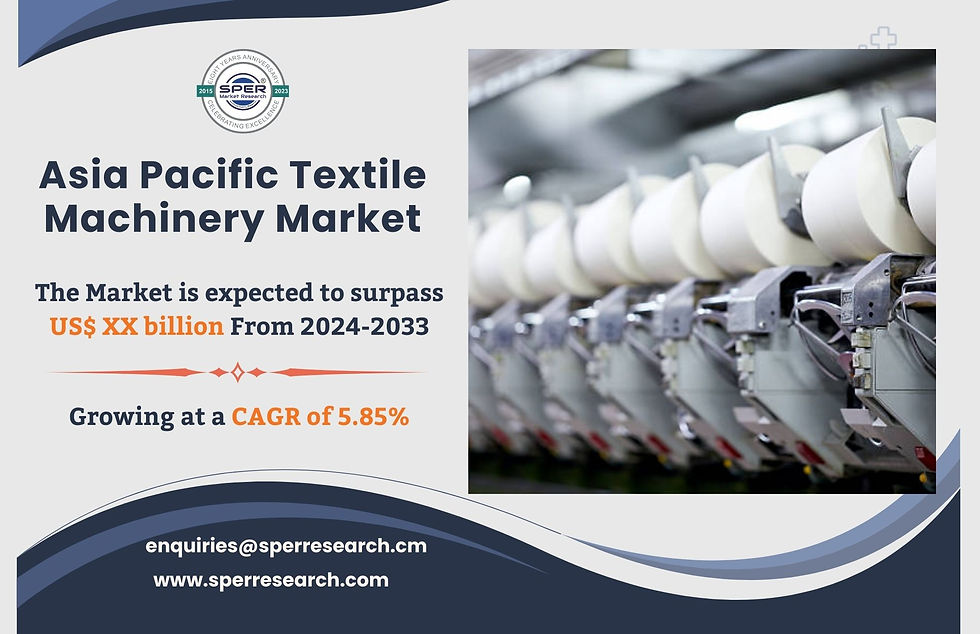Asia Pacific Textile Machinery Market Trends and Size, Revenue, Industry Share, Key Manufacturers, Challenges, Opportunities and Forecast 2024-2033
- James Wilson

- Aug 21, 2024
- 3 min read
Textile machinery transforms raw fibres into textiles by weaving, knitting, crocheting, tatting, felting, bonding, and braiding. It encompasses anything from lace making and quilting machines to textile finishing and spinning machinery used in cotton mills, wool mills, and garment factories to manufacture diverse garments. Several producers are currently utilising automated textile machinery to improve product uniformity, reduce manual work, and produce seamless gowns and ensembles with exquisite embroidery.
According to SPER market research, ‘Asia Pacific Textile Machinery Market Size - By Machine Type, By Distribution Channel, By Application - Regional Outlook, Competitive Strategies and Segment Forecast to 2033’ state that the Asia Pacific Textile Machinery Market is predicted to reach USD XX billion by 2033 with a CAGR of 5.85%.

Drivers: The textile machinery market is predicted to rise due to a variety of causes, including the expanding textile sector, changing government policies and regulations, and increasing automation processes. Furthermore, advances in nanotechnology, digital printing, biotechnology, ultrasonic wet processing, and plasma technology all help to drive the expansion of this industry. New machinery has been introduced for various activities like as mercerizing, printing, dyeing, and bleaching. Because the most recent textile finishing technology is employed to increase fabric quality, textile companies are investing in textile machine acquisitions. Wearing nanotechnology-based gear saves energy and resources while generating more useful garments with features such as self-cleaning, fire resistance, and water resistance.
Request for Sample Copy of Report for More Detailed Market Insight - https://www.sperresearch.com/report-store/asia-pacific-textile-machinery-market.aspx?sample=1
Challenges: The high initial capital cost of purchasing modern, high-tech machinery is a substantial market barrier. Textile production gear is frequently expensive, particularly newer ones with digital, automated, and environmentally friendly features. Because of the high capital demand, both new entrants and existing textile firms trying to update their equipment encounter challenges. Small and medium-sized firms (SMEs) may find it particularly difficult to secure the financing needed to invest in cutting-edge equipment, limiting their ability to compete successfully in a rapidly changing market.
The COVID-19 pandemic had a complex impact on the market, causing supply chain disruptions, a decline in demand and investment in machinery, plant closures, a shift in consumer preferences towards basic, comfortable clothing, an increase in the use of digitalization and remote maintenance solutions, a greater emphasis on sustainability and safety in manufacturing processes, and an overall climate of uncertainty that encouraged cautious approaches to machinery purchases. These factors worked together throughout the pandemic to form patterns in the textile machinery industry and continue to influence it going forward.
China dominates the Asia Pacific textile machine market. This domination reflects China's standing as a textile manufacturing superpower. The country's textile sector benefits from a strong infrastructure, a large labour force, access to sufficient raw materials, and a competitive cost structure. Furthermore, China's textile industry is rapidly adopting technical developments such as automation, digitization, and sustainable practices in order to compete in an increasingly competitive global market. Furthermore, A.T.E Private Limited, Trützschler Group SE, VANDEWIELE NV, Rieter Holding Ltd, Lakshmi Machine Works Limited, and Others are among the market's main companies.
Asia Pacific Textile Machinery Market Segments:
By Machine Type:
Spinning Machines
Weaving Machines
Knitting Machines
Texturing Machines
Others
By Distribution Channel:
Direct
Indirect
By Application:
Garments and Apparels
Household and Home Textiles
Protective Textiles
Medical
Automotive
Others
For More Information, refer to below link –
Related Report –
Follow Us –
Contact Us:
Sara Lopes, Business Consultant – U.S.A.
SPER Market Research
+1-347-460-2899











Comments